| Solar eclipse of November 12, 1985 | |
|---|---|
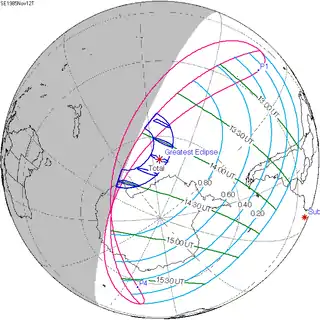 Map | |
| Type of eclipse | |
| Nature | Total |
| Gamma | −0.9795 |
| Magnitude | 1.0388 |
| Maximum eclipse | |
| Duration | 119 sec (1 m 59 s) |
| Coordinates | 68°36′S 142°36′W / 68.6°S 142.6°W |
| Max. width of band | 690 km (430 mi) |
| Times (UTC) | |
| Greatest eclipse | 14:11:27 |
| References | |
| Saros | 152 (11 of 70) |
| Catalog # (SE5000) | 9477 |
A total solar eclipse occurred on November 12, 1985. A solar eclipse occurs when the Moon passes between Earth and the Sun, thereby totally or partly obscuring the image of the Sun for a viewer on Earth. A total solar eclipse occurs when the Moon's apparent diameter is larger than the Sun's, blocking all direct sunlight, turning day into darkness. Totality occurs in a narrow path across Earth's surface, with the partial solar eclipse visible over a surrounding region thousands of kilometres wide. It was visible only near Antarctica.
Related eclipses
Eclipses of 1985
- A total lunar eclipse on May 4.
- A partial solar eclipse on May 19.
- A total lunar eclipse on October 28.
- A total solar eclipse on November 12.
Solar eclipses of 1982–1985
This eclipse is a member of a semester series. An eclipse in a semester series of solar eclipses repeats approximately every 177 days and 4 hours (a semester) at alternating nodes of the Moon's orbit.[1]
Note: Partial solar eclipses on January 25, 1982 and July 20, 1982 occur in the previous lunar year eclipse set.
| Solar eclipse series sets from 1982–1985 | ||||||
|---|---|---|---|---|---|---|
| Ascending node | Descending node | |||||
| Saros | Map | Gamma | Saros | Map | Gamma | |
| 117 | 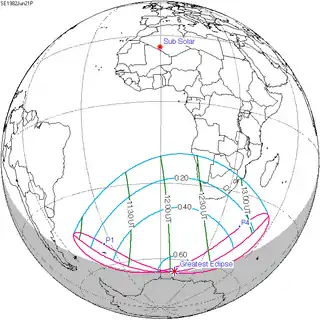 1982 June 21 Partial | −1.21017 | 122 | 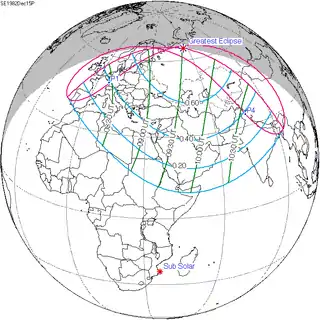 1982 December 15 Partial | 1.12928 | |
| 127 |  1983 June 11 Total | −0.49475 | 132 | 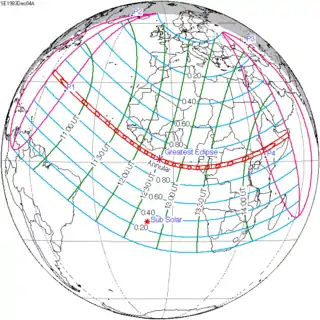 1983 December 4 Annular | 0.40150 | |
| 137 | 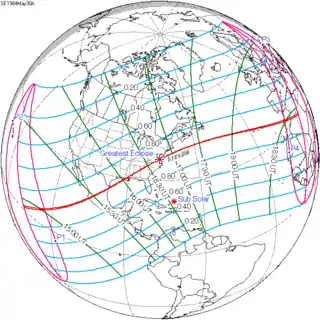 1984 May 30 Annular | 0.27552 | 142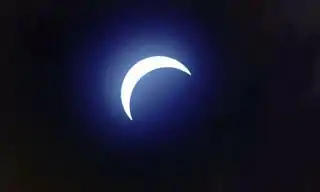 Partial from Gisborne, NZ | 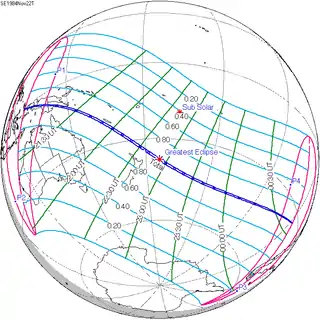 1984 November 22 Total | −0.31318 | |
| 147 |  1985 May 19 Partial | 1.07197 | 152 |  1985 November 12 Total | −0.97948 | |
Saros 152
Solar saros 152, repeating every about 18 years and 11 days, contains 70 events. The series started with a partial solar eclipse on July 26, 1805. It has total eclipses from November 2, 1967, to September 14, 2490; hybrid eclipses from September 26, 2508, to October 17, 2544; and annular eclipses from October 29, 2562, to June 16, 2941. The series ends at member 70 as a partial eclipse on August 20, 3049. The longest total eclipse will occur on June 9, 2328, at 5 minutes and 15 seconds; the longest annular eclipse will occur on February 16, 2743, at 5 minutes and 20 seconds.[2]
| Series members 7–17 occur between 1901 and 2100: | ||
|---|---|---|
| 7 | 8 | 9 |
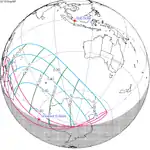 September 30, 1913 |
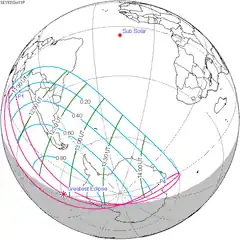 October 11, 1931 |
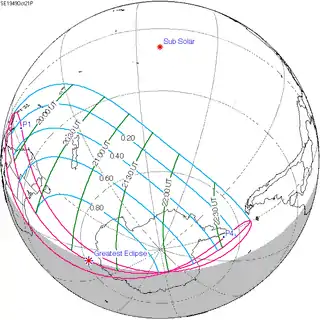 October 21, 1949 |
| 10 | 11 | 12 |
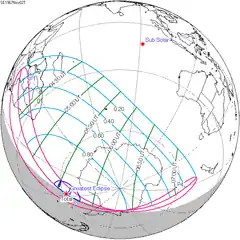 November 2, 1967 |
 November 12, 1985 |
 November 23, 2003 |
| 13 | 14 | 15 |
 December 4, 2021 |
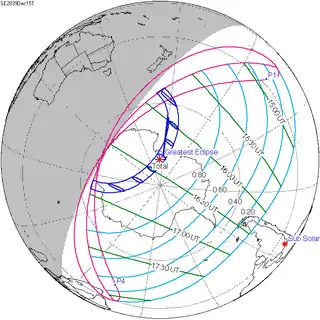 December 15, 2039 |
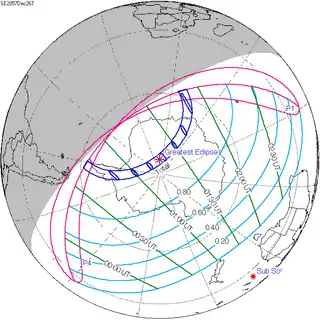 December 26, 2057 |
| 16 | 17 | |
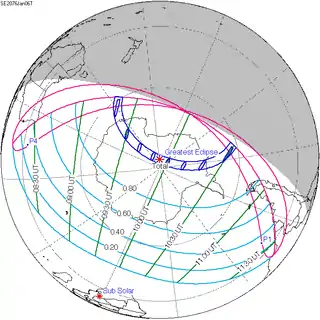 January 6, 2076 |
 January 16, 2094 | |
Metonic series
The metonic series repeats eclipses every 19 years (6939.69 days), lasting about 5 cycles. Eclipses occur in nearly the same calendar date. In addition, the octon subseries repeats 1/5 of that or every 3.8 years (1387.94 days).
| 22 eclipse events, progressing from north to south between April 8, 1902 and August 31, 1989: | ||||
|---|---|---|---|---|
| April 7–8 | January 24–25 | November 12 | August 31-September 1 | June 19–20 |
| 108 | 114 | 116 | ||
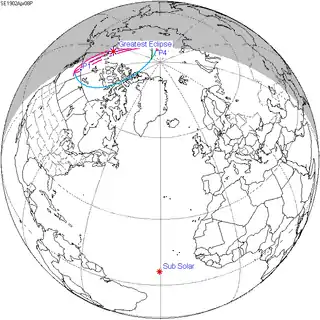 April 8, 1902 |
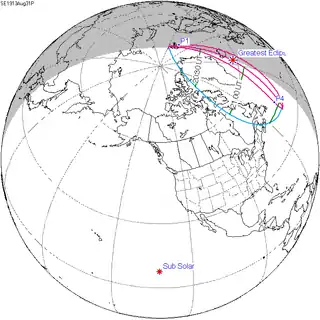 August 31, 1913 |
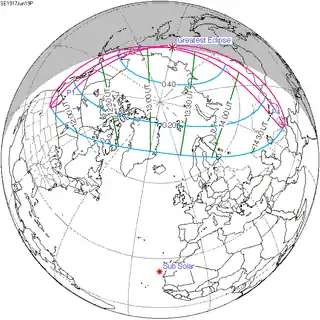 June 19, 1917 | ||
| 118 | 120 | 122 | 124 | 126 |
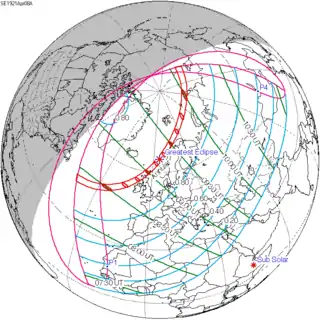 April 8, 1921 |
 January 24, 1925 |
 November 12, 1928 |
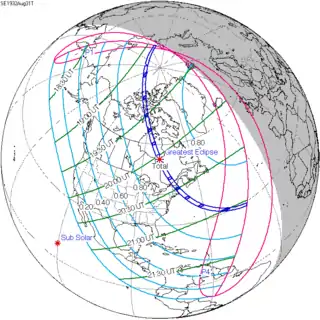 August 31, 1932 |
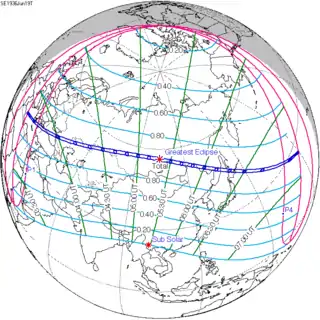 June 19, 1936 |
| 128 | 130 | 132 | 134 | 136 |
 April 7, 1940 |
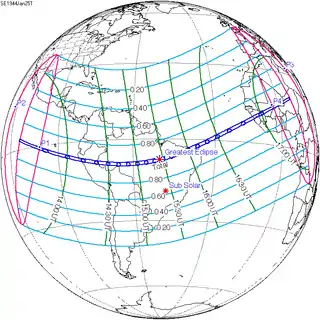 January 25, 1944 |
 November 12, 1947 |
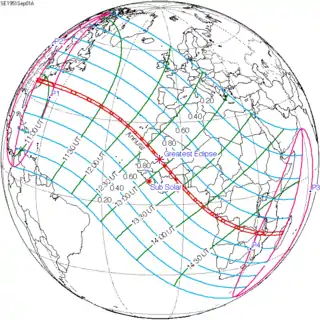 September 1, 1951 |
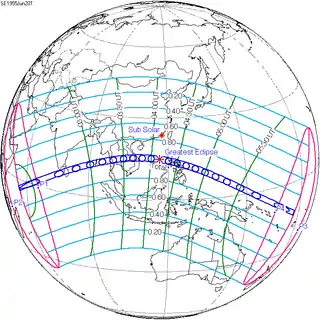 June 20, 1955 |
| 138 | 140 | 142 | 144 | 146 |
 April 8, 1959 |
 January 25, 1963 |
 November 12, 1966 |
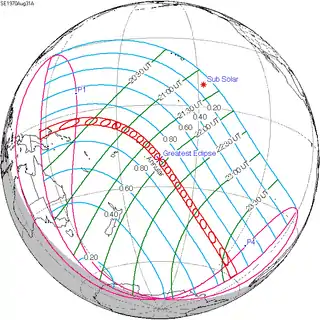 August 31, 1970 |
 June 20, 1974 |
| 148 | 150 | 152 | 154 | |
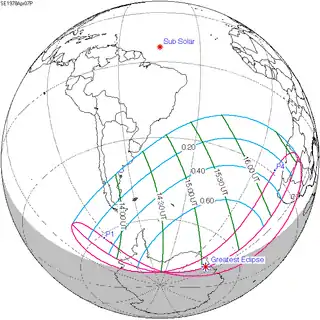 April 7, 1978 |
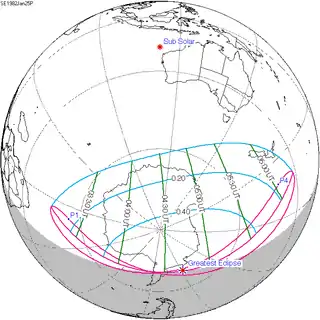 January 25, 1982 |
 November 12, 1985 |
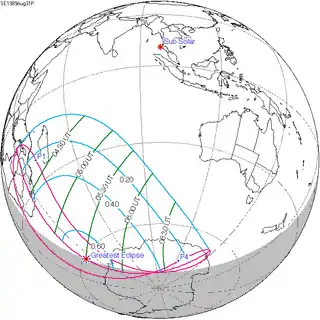 August 31, 1989 | |
Notes
- ↑ van Gent, R.H. "Solar- and Lunar-Eclipse Predictions from Antiquity to the Present". A Catalogue of Eclipse Cycles. Utrecht University. Retrieved 6 October 2018.
- ↑ Saros Series Catalog of Solar Eclipses NASA Eclipse Web Site.
References
- Earth visibility chart and eclipse statistics Eclipse Predictions by Fred Espenak, NASA/GSFC
.jpg.webp)

